Effondrement des tours du World Trade Center
L'effondrement des tours du World Trade Center a été l'évènement central des attentats du 11 Septembre 2001, durant lesquelles chacune des tours jumelles a été frappée par un avion de ligne détourné.

Catégories :
World Trade Center - Attentats du 11 septembre 2001 - Attentat islamiste - Terrorisme islamiste - Violence politique islamiste - Islamisme
Recherche sur Google Images :

Source image : fr.wikipedia.org Cette image est un résultat de recherche de Google Image. Elle est peut-être réduite par rapport à l'originale et/ou protégée par des droits d'auteur. |
Page(s) en rapport avec ce sujet :
- ... La chute des trois tours du World Trade Center | Deux évènements... et l'effondrement de la tour n°7 du World Trade Center qui n'avait été... (source : voltairenet)
- ... Le World Trade Center 7, un immeuble de 47 étages qui faisait... que des dommages superficiels dus à l'effondrement des Tours Jumelles, ... (source : reopen911.wordpress)
- Selon lui, il n'y avait aucun moyen de stopper l'effondrement.... Dans les tours du World Trade Center, la protection des escaliers se résume à des murs... (source : radio-canada)
L'effondrement des tours du World Trade Center a été l'évènement central des attentats du 11 Septembre 2001, durant lesquelles chacune des tours jumelles a été frappée par un avion de ligne détourné. La tour sud (2 WTC) s'est effondrée à 9h59 (heure locale), moins d'une heure après avoir été frappée par le 2e avion. La tour nord (1 WTC) l'a suivie à 10h28 (heure locale) près de 100 minutes après avoir été frappée par le 1er avion.
2 751 personnes qui se trouvaient à l'intérieur ainsi qu'à proximité des tours ont été tuées, en incluant aussi les 157 passagers et personnels d'équipage à bord des deux avions[1]. L'effondrement des tours jumelles a aussi causé d'importants dégâts au reste du complexe ainsi qu'aux bâtiments avoisinants. Donc, à 17h20 (heure locale), la 7 WTC s'est à son tour effondrée[2].
L'Agence fédérale des situations d'urgence (FEMA) a complété son étude sur ces bâtiments en mai 2002. Elle déclara que la conception des tours était bonne et attribua les effondrements à des facteurs dépassant entièrement le contrôle des constructeurs. Quoiqu'appelant pour une étude supplémentaire, la FEMA suggéra que les incendies causés par le crash des avions avaient certainement affaiblit les solives des planchers et initié les effondrements. Selon le rapport de la FEMA – ultérieurement contredit par les conclusions du NIST – les étages se sont détachés de la structure portante des bâtiments et se sont effondrées les uns sur les autres, entrainant un effondrement progressif[3].
La FEMA proposa une explication qui fut rejetée ensuite, d'une investigation plus détaillée du National Institute of Standards and Technology (NIST), qui a été complétée en septembre 2005. Comme la FEMA, le NIST innocenta la conception du WTC, rien dans la sévérité des attaques et l'amplitude des destructions n'étaient au-delà de ce qui a pu être expérimenté dans les villes des États-Unis dans le passé. Le NIST souligna aussi le rôle des incendies, mais n'attribua pas les effondrements à la défaillance des joints des étages. A la place, le NIST trouva que les planchers fléchirent tirant les colonnes vers l'intérieur : "Ceci a mené au fléchissement d'origine des colonnes vers l'intérieur et de l'affaissement de la face sud du WTC 1 et de la face est du WTC 2, initiant l'effondrement de chacune des tours"[4].
Le nettoyage du site impliqua des opérations 24h/24, effectués par de nombreux entrepreneurs, et a couté des centaines de millions de dollars. La démolition des bâtiments endommagés autour continua même quand de nouvelles constructions avaient commencé comme la Freedom Tower. Des bâtiments détruits, seul le 7 World Trade Center a été remplacé, fini en 2008.
La conception
L'architecte Minoru Yamasaki conçut les tours comme des tubes segmentés, qui apporterent aux locataires des étages vastes et dégagés, sans colonnes ni murs. Ce fut fait avec de nombreuses colonnes faiblement espacées pour supporter l'essentiel du poids de la structure, partagé avec des colonnes du cœur. Au-dessus du 7e étage il y avait 59 colonnes externes à chaque face des tours et 47 colonnes dans le cœur[5]. L'ensemble des ascenseurs et les escaliers étaient positionnés dans le cœur, laissant un large espace libre de colonnes entre le périmètre externe qui était relié au cœur par des poutres pré-fabriquées[6].
Les étages étaient constitués de plaques de béton léger d'une épaisseur de 10 cm (4 inch) reposant sur un treillis d'acier. Une grille of lightweight bridging trusses and main trusses supported the floors. The trusses had a span of 18, 2 m (60 feet) in the long-span areas and 11 m (35 feet) in the short span area[6]. The trusses étaient connectés au façades par les colonnes externes, et étaient therefore on 2, 03 m (6 foot 8 inch) centers. The top chords of the trusses étaient boulonné aux attaches soudées to the spandrels du côté extérieur ainsi qu'à un chenal soudé aux colonnes du cœur du côté interne. Les étages étaient connectés to the perimeter spandrel plates avec viscoélastique dampers, qui réduisaient la sensation de balancement ressentie par les occupants. The trusses supported une plaque de béton léger de 10 cm (4 inch) d'épaisseur, qui partage des connections pour une action combinée[6].
Les tours incorporaient aussi a "hat truss" or "outrigger truss" positionné entre le 107e et le 110e étage, qui consistaient en 6 trusses au long de l'axe du cœur et 4 along the short axis. This truss system permettait une redistribution des charges entre les colonnes de la façade externe et celles du cœur. On y a attribué un rôle clé dans l'effondrement[6].
Les concepteurs avaient envisagé les effets de l'impact d'un avion commercial et pensaient que les structures resteraient debout lors d'un tel événement. Mais le NIST trouva une raison de penser qu'ils ont manqué d'estimer correctement l'effet de tels impacts sur les structures, et spécifiquement les effets des incendies.
Dégâts causés par les collisions des avions contre les tours
Les pirates de l'air lancèrent deux avions de ligne Bœing 767, le vol 11 American Airlines (un Bœing 767-200ER) et le vol 175 United Airlines (un Bœing 767-200), dans les tours. Le 1 WTC fut touché à 8 h 46 par le vol 11 entre les 99e et 93e étages. Le 2 WTC fut touché à 9 h 03 par le vol 175 entre les 85e et 77e étages.
Un Bœing 767-200 fait 48, 5 m (160 ft) de long et a une envergure de 48 m (156 ft), avec une capacité allant jusqu'à 62, 2 (-200) ou 91 (-200ER) m³ de carburant. [7] Les avions ont percuté les tours à des vitesses particulièrement élevées. Le vol 11 volait à 700 km/h (440 mph) lorsqu'il s'écrasa dans le 1 WTC, la tour Nord; le vol 175 percuta le 2 WTC, la tour Sud, à à peu près 870 km/h (540 mph). [6] In addition to severing a number of load-bearing columns, the resulting explosions in each tower ignited 38 m³ (10, 000 gallons) [3] of jet fuel and immediately spread the fire to several different floors while consuming paper, furniture, carpeting, computers, books, walls, framing, and other items in all the affected floors. The force of the explosion from the d'origine impact in 1 WTC traveled through at least one express elevator shaft all the way down to the lobby floor, blowing out all of the windows and leaving a number of people insulted.
Les incendies
La construction légère et la nature creuse des structures a permis au carburant de pénétrer jusqu'au sein des tours, déclenchant de nombreux feux simultanément au-dessus d'une grande surface des étages touchés. Le carburant des avions brula tout au plus quelques minutes, mais l'intérieur des bâtiments brula plus d'une heure voir une heure et demi. [8] It has been suggested that the fires might not have been as centrally positioned, nor as intense, had traditionally heavy high-rise construction been standing in the way of the aircraft. Debris and fuel would likely have remained mostly outside the buildings or concentrated in more peripheral areas away from the building cores, which would then not have become unique failure points. Dans ce scénario, les tours auraient pu tenir plus longtemps, peut-être indéfiniment. [9], [10] Les incendies furent assez chaud pour affaiblir les colonnes et causer l'affaissement des étages, tirant les colonnes extérieures vers l'intérieur et réduisant leur capacité à supporter la masse supérieure de l'immeuble. [11]
Dégradation de la situation
Les appels téléphoniques des personnes piégées aux étages supérieurs ont relayé des information via le 9-1-1 sur la situation. À 9 h 37, une personne bloquée au 105e étage de la tour Sud signala que les étages inférieurs "dans les 90e étages" s'étaient effondrés. [12] La dégradation de la situation fut aussi signalée par les hélicoptères de l'unité aérienne du NYPD. [12]
- 9 h 52 - L'unité aérienne du NYPD signale à la radio que : "d'important débris pourraient tombés du haut du 2 WTC. D'importants débris sont accrochés ici. "
- 9 h 59 - Ils signalent que la tour Sud s'effondre.
Les hélicoptères du NYPD signalent la dégradation de la situation de la tour Nord. [12]
- 10 h 20 - L'unité aérienne du NYPD signale que le haut de la tour pourrait pencher.
- 10 h 21 - Ils signalent que la tour Nord se plie vers le coin Sud-Est et se penche vers le Sud.
- 10 h 27 - L'unité aérienne signale que le toit est sur le point de s'effondrer.
- 10 h 28 - Le NYPD signale que la tour s'effondre.
With dispatchers overwhelmed, il y avait peu de communication avec le NYPD, et le FDNY avait des problèmes avec des radios défectueuses. Les pompiers au sein des tours n'entendirent pas l'ordre d'évacuation de leurs supérieurs sur les lieux. 343 pompiers moururent dans les Twin Towers, suite à l'effondrement des bâtiments. [13], [14], [15]
Effondrement des Tours-Jumelles
À 9h59, la tour sud s'effondre, 56 minutes après la collision. La tour nord percutée à 8h46, s'effondrera à 10h28, soit 102 minutes après qu'elle fut impactée. Ces effondrements produiront d'énormes nuages de poussières et couvriront une grande partie de la presqu'ile de Manhattan pendant plusieurs jours. Pour l'origine de chacun des effondrements, il est couramment accepté que la défaillance des structures endommagées suite au choc créé par la collision des avions a entrainé la chute de de la partie supérieure à l'impact des immeubles sur les parties inférieures. Donc, chacun des immeubles se sont écroulés symétriquement et de manière plus ou moins perpendiculaire au sol malgré l'inclinaison prise par le sommet des immeubles lors de leurs chutes et de l'apparente dispersion des débris au sol. Plus l'effondrement progressait, plus il produisait de poussières et de débris qui étaient expulsés par les fenêtres localisées en dessous du front descendant de destruction.
Mécanique des effondrements
Owing to differences in the d'origine impacts, the collapses of the two towers were found to differ in some respects, but in both cases, the same sequence of events applies. After the impacts had severed exterior columns and damaged core columns, the loads on these columns were redistributed. The hat trusses at the top of each building played a significant role in this redistribution of the loads in the structure. [16]
The impacts also dislodged some of the fireproofing from the steel, increasing its exposure to the heat of the fires. In the 102 minutes before the collapse of 1 WTC, the fires reached temperatures that, although well below the melting point, were high enough to weaken the core columns so that they underwent plastic deformation and creep from the weight of higher floors. The NIST report provides a useful model of the situation.
«At this point, the core of WTC 1 could be imagined to be in three sections. There was a bottom section below the impact floors that could be thought of as a strong, rigid box, structurally undamaged and at almost normal temperature. There was a top section above the impact and fire floors that was also a heavy, rigid box. In the middle was the third section, partially damaged by the aircraft and weakened by heat from the fires. The core of the top section tried to move downward, but was held up by the hat truss. The hat truss, in turn redistributed the load to the perimeter columns. (p. 29) »
The situation was similar in 2 WTC. In both towers, perimeter columns and floors were also weakened by the heat of the fires, causing the floors to sag and exerting an inward force on exterior walls of the building.
At 9 :59 a. m., 56 minutes after impact, the sagging floors finally caused the eastern face of 2 WTC to buckle, transferring its loads back to the failing core through the hat truss and initiating the collapse; the section above the impact area then tilted in the direction of the failed wall. At 10 :28 a. m., 102 minutes after the impact, the south wall of 1 WTC buckled, with similar consequences. After collapse ensued, the total collapse of the towers was inevitable due to the enormous weight of the towers above the impact areas.
A combination of three factors allowed the north tower to remain standing longer, the region of impact was higher (so the gravity load on the most damaged area was lighter), the speed of the plane was lower (so there was less impact damage), and the affected floors had received partially upgraded fire proofing. [16]
Total progressive collapse
Analysis of video footage capturing the d'origine collapse and analysis of seismic data from Palisades (New York) shows that the first fragments of the outer walls of the collapsed north tower struck the ground 9 seconds after the collapse started, and parts of the south tower after 11 seconds. The cores of the buildings began to fall 15 to 25 seconds after the d'origine start of the collapse. These times are approximate because dust obscured the view. [17][18]
The NIST report analyzes the failure mechanism in detail. An early analysis explains that the kinetic energy of the upper portion of the building falling onto the story below exceeded by an order of magnitude the amount of energy that the lower story could absorb, [19] crushing it and adding to the kinetic energy. This scenario repeated with each successive story, crushing the entire tower at near free-fall speed. [20]
Effondrement du bâtiment 7 du World Trade Center
.
Le complexe du World Trade Center était composé de sept immeubles, dont trois se sont totalement effondrés le jour des attentats. Le 11 septembre 2001 à 17 h 20, le bâtiment 7 du World Trade Center, un gratte-ciel à charpente métallique de 47 étages et de 186 m de hauteur, scindé du reste du complexe par la Vesey Street, fut la troisième tour à s'effondrer. Contrairement aux Tours Jumelles, l'effondrement du WTC 7 avait été anticipé plusieurs heures à l'avance et le bâtiment était vide. Les pompiers avaient utilisé un theodolite pour évaluer les proportions d'une déformation visible sur la façade. [21]
Le rapport provisoire de la FEMA était peu concluant[22], et l'effondrement du WTC 7 n'était pas mentionné dans le rapport final du NIST sur l'effondrement du World Trade Center lorsqu'il a été publié en septembre 2005. Excepté une lettre adressée au Journal of Metallurgy, qui suggérait que certaines des structures d'acier avaient été exposées à des températures suffisantes pour les faire fondre[23], aucune étude sur l'effondrement du WTC 7 n'avait été publiée dans une revue scientifique.
Le NIST publia un nouveau rapport en juin 2004, exposant brièvement des hypothèses à ce sujet. On this hypothesis a local failure in a critical column, caused by damage from either fire or falling debris from the collapses of the two towers, progressed first vertically and then horizontally to result in "a disproportionate collapse of the entire structure". [24], [25] Though it is not considering a controlled demolition hypothesis, NIST is developing hypothetical blast scenarios that could have caused the buildings structure to fail. It anticipates the release of a draft report of 7 World Trade Center in 2008. [26]
Historique de l'enquête
D'origine reaction
L'effondrement du Worl Trade Center arriva comme une surprise pour les ingénieurs. "Before 9/11, " wrote the New Civil Engineer, "it had been genuinely inconceivable that structures of such magnitude could succumb to this fate. "[27] Quoique les dégâts génèrés par les avions étaient sévères, ils étaient situés sur quelques étages de chaque tour. Le défit pour les ingénieurs était d'expliquer comme des dégâts situés ont put provoquer l'effondrement progressif de trois des plus grand édifices du monde. [20] Interviewé par la BBC en octobre 2001, l'architecte anglais Bob Halvorson prédit correctement qu'il y aurait "un débat pour savoir si oui ou non les tours du World Trade Center auraient du s'effondrer tel que cela s'est produit. " L'étude impliquerait une analyse minutieuse des plans du WTC, de sa construction, des témoignages des témoins oculaires, des vidéos des effondrements, et l'examen des décombres. Soulignant la difficulté de la tâche, Halvorson a déclaré que les effondrements étaient "well beyond realistic experience. "[28]
Authority
Immédiatement après les effondrements, il y avait une certaine confusion au sujet de l'autorité qui mènera une enquête officielle. Quoiqu'il y ait une procédure claire pour les accidents d'avions, aucune agence n'est désignée à l'avance pour enquêter sur les effondrement des bâtiments. [29] Une équipe fut rapidement réunie par le Structural Engineers Institute de l'American Society of Civil Engineers. Il y eu aussi l'American Institute of Steel Construction, l'American Concrete Institute, la National Fire Protection Association et la Society of Fire Protection Engineers. [30] L'ASCE ultimately invited la FEMA à rejoindre l'enquête, which was completed under the auspices of the latter. [30]
L'enquête fut critiquée par certains ingénieurs et lawmakers aux États-Unis. Il y avait peu de financement, aucune autorité pour demander des preuves et limiter l'accès au site du World Trade Center. Un point majeur de discorde à ce moment fut que le nettoyage du site génèra la destruction de la majorité des composants en acier des bâtiments. [31] En effet, lorsque le NIST publia son rapport, il nota "la rareté des preuves matériels" qu'il avait eu à sa disposition pour enquêter sur les effondrements. Seule une fraction d'un pour cent des bâtiments est restée pour l'analyse après que le nettoyage fut terminé : soit quelque 236 pièces d'acier. [16]
La FEMA publia son rapport en mai 2002. Quoique le NIST avait toujours annoncé son intention d'enquêter sur les effondrements au mois d'août de la même année, by 11 septembre 2002 (un an parès la catastrophe), there was growing public pressure for a more thorough investigation. [32] Congress passed the National Construction Safety Team bill in octobre 2002. This provided the authority for the NIST investigation, qui a publié ses résultats en septembre 2005. [16]
Design analysis
One question that investigators tried to answer was whether the buildings had been designed to survive events like those on 9/11. The WTC towers were, of course, designed to survive foreseeable fires[33] and, while "no building code in the United States has specific design requirements for impact of aircraft", [34] the scenario was considered by the structural engineers. NIST, however, found it difficult to document how the buildings were designed to anticipate aircraft impact. [35], [36]
Two accounts of the designers'anticipation of aircraft impact have been suggested in the course of the investigations. FEMA described the modeled aircraft as weighing 263, 000 lb (119 metric tons) with a flight speed of 180 mph (290 km/h), both of which were exceeded in the actual impacts of 9/11. [3] This description follows Leslie Robertson's remarks in the days immediately following the collapses. [37] Robertson, who had participated in the structural design of the towers, recalled he "addressed the question of an airplane collision, if only to satisfy his engineer's curiosity". NIST was unable to document this reported study; Robertson could not find a copy and it was not an official study done by the WTC engineers. Journalists investigating the issue were also unable to find anyone to verify Robertson's recollection. [38]
NIST did find a three page white paper from 1964 summarizing an extensive WTC structural study that included the effects of a Bœing 707 weighing 336, 000 lb (152 metric tons) and carrying 23, 000 US gallons (87 m³) of fuel impacting the 80th floor of the buildings at Modèle :Convert. While this suggests planes that were faster than those that crashed into the towers on 9/11, the study found that the buildings would not collapse on such a scenario. [39] This study is more in line with remarks made by John Skilling's after the 1993 bombing. [40] When asked about this study by The New York Times Magazine, Robertson insisted that he had no knowledge of this study and that it had not actually been carried out.
It is unclear whether the effect of jet fuel and aircraft contents was a consideration in the original building design. "One view, " writes NIST, "suggests that an analysis was done indicating the biggest problem would be the fact that all the fuel would dump into the building and there would be a horrendous fire. Another view suggests that the fuel load, and the fire damage that it would cause, may not have been considered. "[41], [42] Without the original calculations, which were used to render its conclusions, [43] NIST said, any further comment would amount to speculation. [44]
FEMA's pancake collapse theory
FEMA developed an early explanation of the collapses, which had come to be known as the "pancake" theory. It was defended by Thomas Eagar and popularized by PBS. [45] According to this explanation, when the connections between the floor trusses and the columns broke, the floors fell down one on top of the other, quickly exceeding the load that any one floor was designed to carry. [46] A number of self-published accounts by structural engineers suggested that a combination of factors led to the collapse, but most suggested a version of pancake collapse. [47], [10]
As in the theory which is currently accepted, the fires were taken to be the key to the collapses. Thomas Eagar, an MIT materials professor, had described the fires as "the most misunderstood part of the WTC collapse". [46] This is because the fires were originally said to have "melted" the floors and columns. As Eagar said, "The temperature of the fire at the WTC was not unusual, and it was most definitely not capable of melting steel. " Jet fuel is essentially kerosene and would have served mainly to ignite very large, but not unusually hot, hydrocarbon fires. This led Eagar, FEMA and others to focus on what appeared to be the weakest point of the structures, namely, the points at which the floors were attached to the building frame. Once these connections failed, the pancake collapse could initiate. [48], [49] The NIST report, however, would ultimately vindicate the floor connections; indeed, the collapse mechanism depends on the strength of these connections as the floors pulled the outer walls in.
Early column failure theories
NIST's column failure theory had already been articulated, not least by Bažant and Zhou. MIT civil engineers Oral Buyukozturk and Franz-Josef Ulm, probably following Bažant's early proposal, also described a collapse mechanism on 21 septembre 2001. [50]
They would later contribute to an MIT collection of papers on the WTC collapses edited by Eduardo Kausel called The Towers Lost and Beyond, published in mai 2002. [51]
The NIST report
Design of the study
After the FEMA report had been published, and following pressure from technical experts, industry leaders and families of victims, the Commerce Department's National Institute of Standards and Technology conducted a three-year, 24 million investigation into the structural failure and progressive collapse of several WTC complex structures. [52] The study included in-house technical expertise and drew upon the knowledge of several outside private institutions for aid to include :
-
- Structural Engineering Institute of the American Society of Civil Engineers
- Society of Fire Protection Engineers
- National Fire Protection Association
- American Institute of Steel Construction
- Council on Tall Buildings and Urban Habitat
- Structural Engineers Association of New York
Scope and limits
The scope of the NIST investigation was limited to "the sequence of events from the instant of aircraft impact to the initiation of collapse for each tower" and "includes little analysis of the structural behavior of the tower after the conditions for collapse initiation were reached and collapse became inevitable. "[53] In line with the concerns of most engineers, NIST focused on the airplane impacts and the spread and effects of the fires, modeling these at a very high level of detail. NIST developed several highly detailed structural models for specific sub-systems such as the floor trusses as well as a global model of the towers as a whole which is less detailed. These models are static or quasi-static, including deformation but not the motion of structural elements after rupture as would dynamic models. So, the NIST models are useful for determining how the collapse was triggered, but do not shed light on events after that point.
Ongoing investigations
In 2003, three engineers at the University of Edinburgh published a paper in which they provisionally concluded that the fires alone (without any damage from the airplanes) could have been enough to bring down the WTC buildings. In their view, the towers were uniquely vulnerable to the effects of large fires on several floors at the same time. [54] When the NIST report was published, Barbara Lane, with the UK engineering firm Arup, criticized its conclusion that the structural damage resulting from the airplane impacts was a necessary factor in causing the collapses. [55] Jose L Torero from the BRE Centre for Fire Safety Engineering at the University of Edinburgh is pursuing further research into the potentially catastrophic effects of fire on real-scale buildings. [56], [57], [58]
Criticism
James Quintiere, professor of fire protection engineering at the University of Maryland, called the spoliation of the steel "a gross error" that NIST should have openly criticized. [59] He also noted that the report lacked a timeline and physical evidence to support its conclusions. [60]
Some engineers have suggested that our understanding of the collapse mechanism could be improved by developing an animated sequence of the collapses based on a global dynamic model, and comparing it with the video evidence of the actual collapses. In octobre 2005, the New Civil Engineer reported criticism of NIST's computer modelling. Colin Bailey at the University of Manchester and Rober Plank at the University of Sheffield called on NIST to produce computer visualizations of the collapses in order to correlate the collapse models with observed events. [61]
Remarks by Osama bin Laden
Although its translation is contested, [62], [63] a videotape of Osama bin Laden verified by the Pentagon indicates that Bin Laden did not believe that the buildings would collapse completely, but only those levels above where the planes struck :
«We calculated in advance the number of casualties from the enemy, who would be killed based on the position of the tower. We calculated that the floors that would be hit would be three or four floors. I was the most optimistic of them all. (... Inaudible... ) Due to my experience in this field, I was thinking that the fire from the gas in the plane would melt the iron structure of the building and collapse the area where the plane hit and all the floors above it only. This is all that we had hoped for. [64]»
Other buildings
The entire WTC complex was destroyed on 11 septembre 2001, and many of the surrounding buildings were also either damaged or destroyed as the towers fell. 5 WTC suffered a large fire and a partial collapse of its steel structure.
Other buildings destroyed include St. Nicholas Greek Orthodox Church, Marriott World Trade Center (Marriott Hotel 3 WTC), South Plaza (4 WTC), and U. S. Customs (6 WTC). The World Financial Center buildings, 90 West Street, and 130 Cedar Street suffered fires. The Deutsche Bank Building, Verizon, and World Financial Center 3 suffered impact damage from the towers'collapse, as did 90 West Street. One Liberty Plaza survived structurally intact but sustained surface damage including shattered windows. 30 West Broadway was damaged by the collapse of 7 WTC. The Deutsche Bank Building, which was covered in a large black "shroud" after 11 septembre to cover the building's damage, is currently being deconstructed because of water, mold, and other severe damage caused by the neighboring towers'collapse. [65]
Aftermath
Site cleanup
The colossal pile of debris left on the site burned for three months, resisting attempts to extinguish the blaze until the majority of the rubble was finally removed from the site. [66], [67] The cleanup was a massive operation coordinated by the City of New York Department of Design and Construction (DDC).
On 22 septembre, a preliminary cleanup plan was delivered by Controlled Demolition Inc. (CDI) of Phœnix. Mark Loizeaux, president of CDI, emphasized the importance of protecting the slurry wall (or "the bathtub ") which kept the Hudson river from flooding the WTC's basement. [68] It involved round-the-clock operations, many contractors and sub-contractors, and cost hundreds of millions of dollars. [69] By early november, with a third of the debris removed, officials began to reduce the number of firefighters and police officers assigned to recovering the remains of victims, in order to prioritize the removal of debris. This caused confrontations with firefighters. [70] In 2007, the demolition of the surrounding damaged buildings was still ongoing, even as new construction proceeded on the World Trade Center's replacement, the Freedom Tower.
Air quality and the EPA's response
On 18 septembre, 2001, the Environmental Protection Agency issued a statement assuring the public that the air in Manhattan was "safe to breathe". [71] In a report published in 2003, however, the EPA's inspector general found that the agency did not at that time have sufficient data to make such a statement. Also, it found that the White House had influenced the EPA to remove cautionary statements and include assuring ones, in part motivated by the desire to reopen Wall Street. In fact, the collapse of the World Trade Center resulted in serious reductions in air quality and is likely the cause of many respiratory illnesses among first responders, residents, and office workers in lower Manhattan. [72]
Démolition contrôlée et théories du complot
En 2006, selon un sondage, 16% des Américains pensent que le World Trade Center a pu être détruit, non pas à cause des avions, mais par démolitions contrôlées. [73]
Cette idée a été rejeté par le NIST, concluant que la présence d'explosifs est négative et que cette hypothèse ne doit pas être considérer comme envisageable. [17]
L'hypothèse de la théorie de la démolition contrôlée des tours du complexe (dans ce cas ci : les deux Tours Jumelles et le bâtiment 7) a aussi été rejetée dans le domaine littéraire, mais elle se trouve émise dans les différentes théories du complot liées aux attentats de septembre 2001. [74]
Voir aussi
- Health effects arising from the September 11, 2001 attacks
- Plans to rebuild the World Trade Center
Références
- (en) Cet article est partiellement ou en totalité issu de l'article de Wikipédia en anglais intitulé «Collapse of the World Trade Center» (voir la liste des auteurs) (voir aussi la page de discussion).
Cited references
- ↑ (en) Relatives gather at ground zero to mark 9/11, The Associated Press / MSNBC (9 Septembre 2007). Consulté le 03/11/2007.
- ↑ (en) PartIIC - WTC 7 Collapse, 5 avril 2005, NIST Response to the World Trade Center Disaster, National Institute of Standards and Technology. Consulté le 01/11/2006
- (en) Ronald, et al Hamburger, «World Trade Center Building Performance Study», Agence fédérale des situations d'urgence. Consulté le 2006-07-27
- ↑ (en) NIST Response to the World Trade Center Disaster. Consulté le 2008-04-23
- ↑ (en) National Construction Safety Team, Final Report on the Collapse of the World Trade Center Towers, NIST, PDF, «Chapter 1», p. p. 6
- (en) (en) National Construction Safety Team, Final Report on the Collapse of the World Trade Center Towers, NIST, PDF
- ↑ Bœing 767, 2001, Jane's. Consulté le 2007-08-19
- ↑ Andy Field, «A Look Inside a Radical New Theory of the WTC Collapse», 2004, Fire/Rescue News. Consulté le 2006-07-28
- ↑ John L., Therese P. McAllister Gross, «Structural Fire Response and Probable Collapse Sequence of the World Trade Center Towers», 2004, Federal Building and Fire Safety Investigation of the World Trade Center Disaster NIST NCSTAR 1-6, National Institute of Standards and Technology. Consulté le 2006-07-28
- Tim Wilkinson, «World Trade Center - Some Engineering Aspects», 2006. Consulté le 2006-07-28
- ↑ (en) National Construction Safety Team, Final Report on the Collapse of the World Trade Center Towers, NIST, «Executive Summary»
- Lawson, J. Randall, Robert L. Vettori, «NIST NCSTAR 1-8 - The Emergency Response», Septembre 2005, National Institute of Standards and Technology
- ↑ McKinsey Report - Emergency Medical Service response, 9 août 2002, FDNY / McKinsey & Company. Consulté le 2007-07-12
- ↑ McKinsey Report - NYPD, 19 août 2002. Consulté le 2007-07-10
- ↑ "NY Firefighters attack Giuliani, " BBC News, 12 juillet 2007 http ://news. bbc. co. uk/2/hi/americas/6294198. stm
- NIST's Responsibilities Under the National Construction Safety Team Act
- Answers to Frequently Asked Questions, NIST & The World Trade Center, National Institute of Standards and Technology. Consulté le 2006-09-17
- ↑ Department of Civil and Environmental Engineering, Northwestern University, Evanston, Illinois 60208, USA, «Collapse of World Trade Center Towers : What Did and Did Not Cause It?». Consulté le 27/05/2007
- ↑ Zdeněk P. Bažant, «Why Did the World Trade Center Collapse?—Simple Analysis», dans Journal of Engineering Mechanics, vol. 128, no 1, Janvier, p. pp. 2-6 [texte intégral lien DOI (pages consultées le 2007-08-23) ]
- Zdeněk P. Bažant, «Mechanics of Progressive Collapse : Learning from World Trade Center and Building Demolitions», dans J. Engrg. Mech. , vol. 133, no 3, Mars 2007, p. pp. 308-319 [texte intégral lien DOI (pages consultées le 2007-08-22) ]
- ↑ Hayden, Peter, «WTC : This Is Their Story», Avril 2002, Firehouse Magazine
- ↑ Observations, findings and Recommendations, World Trade Center Building Performance Study, (Chapter 8.2.5.1) , Federal Emergency Management Agency. Consulté le 2006-07-28
- ↑ J. R. Barnett, R. R. Biederman, R. D. Sisson Jr., «An D'origine Microstructural Analysis of A36 Steel from WTC Building 7», 2001, Feature : Letter, The Journal of Materials. Consulté le 2006-05-12
- ↑ Key Findings of NIST's Juin 2004 Progress Report on the Federal Building and Fire Safety Investigation of the World Trade Center Disaster, 2004, Fact sheets from NIST, National Institute of Standards and Technology. Consulté le 2006-07-28
- ↑ Interim Report on WTC 7, 2004, Appendix L, National Institute of Standards and Technology. Consulté le 2006-07-28
- ↑ Sunder, S. Shyam (18 décembre 2007). "Opening Remarks and Overview of WTC 7 Investigation" in NCST Advisory Committee Meeting. Proceedings, NIST.
- ↑ Anthony Oliver, «Lasting lessons of WTC», 30 juin 2005, New Civil Engineer. Consulté le 2006-07-28
- ↑ David Whitehouse, «WTC collapse forces skyscraper rethink», 2001, BBC News. Consulté le 2006-07-28
- ↑ Snell, Jack. "The Proposed National Construction Safety Team Act. " NIST Building and Fire Research Laboratory. 2002. [1]
- Experts Debate Future of the Skyscraper in Wake of Disaster, Engineering News-Record (24 septembre 2001).
- ↑ Glanz, James and Eric Lipton. "Nation Challenged : The Towers; Experts Urging Broader Inquiry In Towers'Fall". New York Times 25 décembre 2001
- ↑ Dwyer, Jim. "Investigating 9/11 : An Unimaginable Calamity, Still Largely Unexamined". New York Times. 11 septembre 2002 [2]
- ↑ Fireproofing was incorporated in the original construction and more was added after a fire in 1975 that spread to six floors before being extinguished. After the 1993 bombing, inspections found fireproofing to be deficient. The Port Authority was in the process of replacing it, but replacement had been completed on only 18 floors in 1 WTC, including all the floors affected by the aircraft impact and fires, (NCSTAR 1-6, p lxxi) and on 13 floors in 2 WTC, although only three of these floors (77, 78 & 85) were directly affected by the aircraft impact (NCSTAR 1-6, p lxvii-lxix). Although replacement fireproofing was specified at 1.5 inches in thickness, NIST found the average thickness to be 2.5 inches (NCSTAR 1-6A, p xl). NIST concluded that "the existing condition of the fireproofing prior to aircraft impact and the fireproofing thickness on the WTC floor system did not play a significant role".
- ↑ H. S. Lew, Richard W. Bukowski and Nicholas J. Carino, «Design, Construction and Maintenance of Structural and Life Safety», 2006, NIST NCSTAR 1-1 Pages 70-71, National Institutes of Standards and Technology. Consulté le 2007-10-15
- ↑ NIST Progress Report Mai 2003 pdf
- ↑ The Height of Ambition New York Times 8 septembre 2002
- ↑ Leslie E. Robertson, «Reflections on the World Trade Center», 2002, The Bridge Volume 32, Number 1, National Academy of Engineering. Consulté le 2006-07-28
- ↑ Glanz, James and Eric Lipton. "The Height of Ambition" in the New York Times Magazine, 8 septembre 2002.
- ↑ Sadek, Fahim. Baseline Structural Performance and Aircraft Impact Damage Analysis of the World Trade Center Towers (NCSTAR 1-2 appendix A). NIST 2005. pp. 305-307.
- ↑ Nalder, Eric. "Twin Towers Engineered to Withstand Jet Collision". The Seattle Times. Samedi 27 février 1993. [3]
- ↑ NIST Response to the World Trade Center Disaster NIST pdf
- ↑ NIST's Working Hypothesis for Collapse of the WTC Towers (Appendix Q) , Juin 2004, NIST. Consulté le 2007-12-21
- ↑ NIST was informed by the Port Authority that the documents cited were destroyed in the collapse of 1 WTC and the WTC owners documents held in 7 WTC were also lost.
- ↑ H. S. Lew, Richard W. Bukowski and Nicholas J. Carino, «Design, Construction and Maintenance of Structural and Life Safety», 2006, NIST NCSTAR 1-1 Page 71, National Institutes of Standards and Technology. Consulté le 2007-10-15
- ↑ Thomas Eagar, «The Collapse : An Engineer's Perspective», 2002, NOVA. Consulté le 2006-07-28
- Eagar, Thomas W. ; Christopher Musso (2001). Why Did the World Trade Center Collapse? Science, Engineering, and Speculation. JOM, 53 (12). The Minerals, Metals & Materials Society. Retrieved on 2006-05-02.
- ↑ G. Charles Clifton, «Collapse of the World Trade Centre Towers», 2002. Consulté le 2006-07-28
- ↑ How the World Trade Center fell, 2001, BBC News. Consulté le 2006-07-28
- ↑ Twin towers'steel under scrutiny, 2001, BBC News. Consulté le 2006-07-28
- ↑ Oral, Franz-Josef Ulm Buyukozturk, «How safe are our skyscrapers? : The World Trade Center collapse», 2001, Massachusetts Institute of Technology. Consulté le 2006-06-26
- ↑ Eduardo Kausel, «The Towers Lost and Beyond», 2002, Massachusetts Institute of Technology. Consulté le 2006-06-26
- ↑ Michæl E. Newman, «Commerce's NIST Details Federal Investigation of World Trade Center Collapse», 2002, National Institute of Standards and Technology. Consulté le 2006-07-28
- ↑ NIST final report (2005). NCSTAR 1, p. xxxvii.
- ↑ A. S., Y. C. Chung, J. L. Torero Usmani, «How did the World Trade Center Collapse : A New Theory», 2003, Fire Safety Journal, 38, 6. Consulté le 2007-05-07
- ↑ Row erupts over why twin towers collapsed, 2005, New Civil Engineer. Consulté le 2006-07-28
- ↑ Dalmarnock Full-Scale Experiments 25 & 26 juillet 2006, 2006, BRE Centre for Fire Safety Engineering, University of Edinburgh. Consulté le 2008-04-23
- ↑ Nicholas Christian, «Glasgow tower block to shed light on 9/11 fire», 2006, Scotsman. Consulté le 2006-07-28
- ↑ Skyscraper Fire Fighters, 2007, BBC Horizon. Consulté le 2007-07-31
- ↑ Committee on Science, «THE INVESTIGATION OF THE WORLD TRADE CENTER COLLAPSE : FINDINGS, RECOMMENDATIONS, AND NEXT STEPS», 26 octobre 2005, commdocs. house. gov. Consulté le 2007-04-01
- ↑ Quintiere, James, «"2004 REPORT TO CONGRESS OF THE NATIONAL CONSTRUCTION SAFETY TEAM ADVISORY COMMITTEE"», Décembre 2004, NIST, p. 8
- ↑ Parker, Dave. "WTC investigators resist call for collapse visualisation. " New Civil Engineer 6 octobre 2005.
- ↑ "Bin-Laden-Video : Falschübersetzung als Beweismittel? WDR, Das Erste, MONITOR Nr. 485 am 20 décembre 2001
- ↑ Mark Larson, «Unwinding the Bin Laden tape», 2001, Guardian Unlimited. Consulté le 2006-07-28
- ↑ , 2001, National Public Radio. Consulté le 2006-07-28
- ↑ Bone Fragments Found Near WTC Said Human, 2005, Associated Press. Consulté le 2006-09-11
- ↑ http ://english. people. com. cn/200112/20/eng20011220_87119. shtml
- ↑ CBS News | WTC Fires All But Defeated | 19 décembre 2001 23 :22 :25
- ↑ Post, Nadine M. and Debra K. Rubin. "Debris Mountain Starts to Shrink. " Engineering News Record, 10/1/01. [4]
- ↑ Kugler, Sara : Officials Wanted More Searching at WTC, Washington Post (2006-10-23). Consulté le 2007-10-29.
- ↑ Rubin, Debra K. and Janice L. Tuchman. "WTC Agency Begins Ramping Up Operations. " Engineering News Record, 11/01/01. [5]
- ↑ EPA Response to September 11. Consulté le 2007-08-27
- ↑ United States Environmental Protection Agency Office of Inspector General. "EPA's Response to the World Trade Center Collapse. " Report No. 2003-P-00012.21 août 2003. [6]
- ↑ Hargrove, Thomas and Guido H. Stempel III. More than 40 percent of the New York City and NY State population indicate they believe the WT Centers were destroyed by controlled demolition in turn indicating government complicity according to several Zogby polls. "Anti-government anger spurs 9/11 conspiracy belief", Scripps Howard News Service, 2 août 2006. [7]
- ↑ Meigs James B., «The Conspiracy Industry», 2006, Popular Mechanics, Hearst Communications, Inc.. Consulté le 2006-12-11
Modèle :Refbegin
- (en) Jim Dwyer, 102 Minutes : The Untold Story of the Fight to Survive Inside the Twin Towers, Times Books, 2004 (ISBN ISBN 0-8050-7682-4)
- Technology Administration National Institute of Standards and Technology, «NIST and the World Trade Center», 2006, NIST building and fire safety investigation, US Department of Commerce. Consulté le 2006-05-02
- Tim Wilkinson, «World Trade Center - Some Engineering Aspects», 2006, School of Civil Engineering, The University of Sydney. Consulté le 2006-05-02
- Therese McAllister, W. Gene Corley, et al., «World Trade Center Building Performance Study : Data Collection, Preliminary Observations, and Recommendations (FEMA 403) », 2002, Federal Emergency Management Agency. Consulté le 2006-05-02
- Thomas W. Eagar, Christopher Musso, «Why Did the World Trade Center Collapse? Science, Engineering, and Speculation», 2001, JOM, 53 (12) , The Minerals, Metals & Materials Society. Consulté le 2006-05-02
- Zdeněk P. Bažant, Yong Zhou, «Why Did the World Trade Center Collapse? - Simple Analysis», 2001, Journal of Engineering Mechanics ASCE, 9/13/01, Northwestern University. Consulté le 2006-09-11
- G. Charles Clifton, «Collapse of the World Trade Centre Towers», 2001, CAD Digest, TenLinks, Inc.. Consulté le 2006-05-02
- Dr. Thomas Edgar, NOVA, «The Collapse : An Engineer's Perspective», 2002, Why the Towers Fell, WGBH Educational Foundation. Consulté le 2006-05-02
- A. S. Usmani, Y. C. Chung, J. L. Torero, «How did the WTC towers collapse : a new theory», 2003, Fire Safety Journal, Volume 38, Issue 6, Elsevier Ltd.. Consulté le 2007-05-07
- The structure of metal, 2002, Why the Towers Fell, WGBH Educational Foundation. Consulté le 2006-05-02
- Thomas H. Kean, «Eleventh Public Hearing», 2004, Hearings, National Commission on Terrorist Attacks Upon the United States. Consulté le 2006-05-02
- Seth Kramer, Daniel Miller. (2002) America Rebuilds : A Year at Ground Zero [Television series]. United States : PBS home video.
- Answers to Frequently Asked Questions (August 30, 2006) , 2006, NIST Federal Building and Fire Safety Investigation of the World Trade Center Disaster, National Institute of Standards and Technology. Consulté le 2008-04-21
Modèle :Refend
Liens externes
- NIST and the World Trade Center The National Institute of Standards and Technology's page on the collapse of the WTC. Contains most recent developments in investigations and FAQs.
- World Trade Center - Some Engineering Aspects Early suggestion by University of Sydney engineering instructor about how the towers might have collapsed.
- Bill Biggart's Final Exposures contains a photo of the WTC Marriott severely damaged by the collapse of 2 WTC immediately before the collapse of 1 WTC in which the photographer was killed.
- Video showing fire in corner of 2 WTC
- Forensic animations used in court
Recherche sur Amazone (livres) : |
Voir la liste des contributeurs.
La version présentée ici à été extraite depuis cette source le 08/05/2010.
Ce texte est disponible sous les termes de la licence de documentation libre GNU (GFDL).
La liste des définitions proposées en tête de page est une sélection parmi les résultats obtenus à l'aide de la commande "define:" de Google.
Cette page fait partie du projet Wikibis.
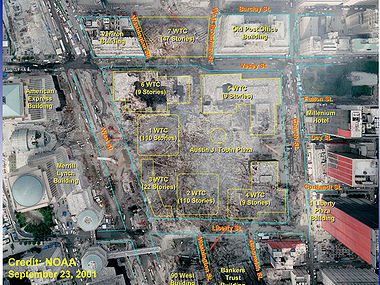
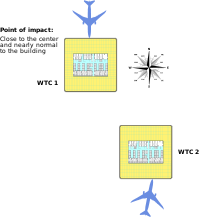
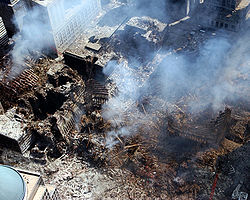
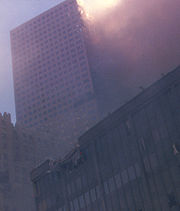
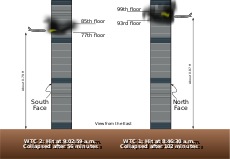
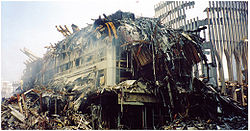
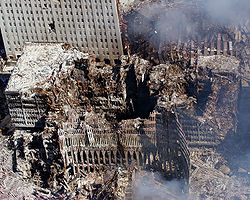
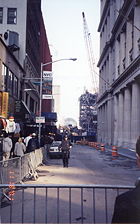
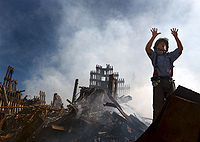
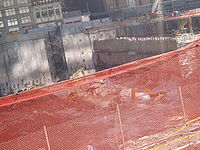

 Accueil
Accueil Recherche
Recherche Début page
Début page Contact
Contact Imprimer
Imprimer Accessibilité
Accessibilité